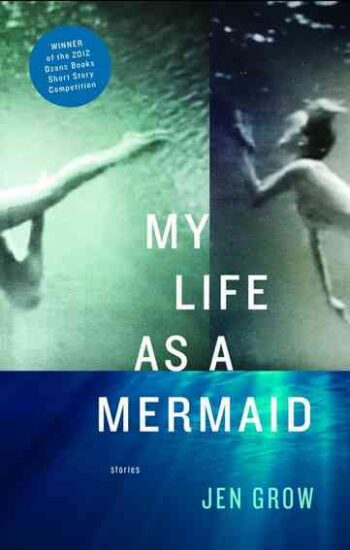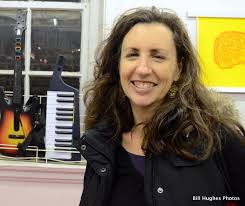
“There was so much I learned the wrong way,” one of Jen Grow’s characters confesses in My Life as a Mermaid, and Other Stories (Dzanc, 2015). And like the other women in Grow’s collection, she is unsure how to navigate the world. Grow’s women lack positive mentors, parents, stabilizing forces in their lives. Rather than following a pattern they’ve observed, Grow’s Mermaid women try. And fail. And try again. They’re not heroes, simply people longing for a better life, without the means to achieve anything beyond than their current circumstances.
As a collection, Grow’s work demonstrates her strength: she is able to capture the world of lower/middle-class life and its intricate detail not as a fact unto itself, but as a tool for articulating the lost hopes and tarnished dreams of her characters. Women in Grow’s collection mourn what they can’t have in their lives, but they are usually unsure of what it would take to have it—whether “it” is a better job, an opportunity to travel, a better man, or something that feels more like love.
In the collection’s title story, a mother constantly compares her own struggles to those of her sister who does volunteer work in Honduras, saying:
Some days I feel like Gulliver. Every part of me tied down by Lilliputians, as if, somehow, it is me and not my sister who has wandered into a strange land. The land of marriage, motherhood, matching socks. It’s not what I expected. How did I choose this, wandering the grocery store with my squeaky cart? Nor is it clear how my sister escaped to Honduras. It seems impossible that all these worlds are connected, the past with the present, Honduras with here.
Grow’s work illuminates the constant comparisons women make—comparing successes, comparing failures, comparing even pain. My Life as a Mermaid demonstrates both the futility of that kind of comparison and its prevalence. Being aware that other people have it worse off does not mitigate the pain in one’s own life—Grow’s characters feel this acutely.
There is a sense, in Grow’s collection, of characters as observers. In the plural first person narration of “Joe Blow,” neighbors observe the poverty that surrounds them. These observations are filtered like light through an aquarium.
We shake our heads at the scene below. From our sidewalks and front doors and from our second-floor windows, we see all. Like God, almost. There’s Joe, there’s Roger, opposite sides of the street, hating something about each other. And the tow truck in the middle, waiting at the end of the block for the light to change green. We could spit on Larry if we wanted to. Hock a lugie on Joe. But when the light turns green, all of us watch quietly as the tow truck makes a turn around the corner and drives out of sight.
Characters critique their neighbors while ironically lacking the ability to escape the same cyclical failures. In both “Joe Blow” and “Camera Obscura: Light Seeps In,” the neighborhood is a thriving organism, vibrant even in its dysfunction. Everyone knows everyone else’s business, and in the case of Grow’s characters, they use everyone else’s business as a benchmark by which to assuage their own discomfort. They’re all thinking that they have it better than someone else.
 “What Girls Leave Behind” is Grow’s most remarkable story, the painful recollections of an alcoholic mother who has lost her daughters. Through jumps in time and careful pacing, Grow unravels her character. The scenarios she places her characters in are heart-rending, but this is often when she gets closest to something universal. “Maybe something else washed by,” the mother thinks—a moment of lucidity in her drunkenness. “A sense that there were layers to this existence, invisible but real: that some larger life was taking place in my own living room where the girls played Barbies and sang and painted.” Though the story is sad, its revelations about the cost of love are astounding.
“What Girls Leave Behind” is Grow’s most remarkable story, the painful recollections of an alcoholic mother who has lost her daughters. Through jumps in time and careful pacing, Grow unravels her character. The scenarios she places her characters in are heart-rending, but this is often when she gets closest to something universal. “Maybe something else washed by,” the mother thinks—a moment of lucidity in her drunkenness. “A sense that there were layers to this existence, invisible but real: that some larger life was taking place in my own living room where the girls played Barbies and sang and painted.” Though the story is sad, its revelations about the cost of love are astounding.
In “Still at War,” the author examines the difficult return of veterans to their families. A wife dutifully attends meetings designed to help her cope with her husband’s PTSD, but she doesn’t account for her own depression.
During commercial breaks, I tried to have conversations, but I didn’t know what to say. “What was it like?” I asked once, but all Douglas told me was. “Believe me, you don’t want to know.” When I got home from work in the evenings, I’d ask, “How are you feeling?” What I meant was, “Tell me anything, please.”
Douglas would say “I’m fine,” or “My leg hurts.”
We answered questions, just not each other’s.
My Life as a Mermaid is often about the “afters.” What happens after war? What happens after the children are taken away? What happens after a mother dies? Grow measures these moments with practicality rather than sentiment. By sticking with her characters as they sit, drunkenly, on the floor, Grow imagines a world that is both sad and beautiful.
My Life as a Mermaid puts women into situations that challenge traditional female roles—as daughters, wives, mothers, and girlfriends, they disappoint. There are no women in these stories that comfort or hold families together. By showing us women at their most intimate moments of pain and loss—in their most disturbing honesty—Grow’s collection highlights the ways we ask women to be more than they are. Her deft writing provides the reader with complex, intimate human portraits. We talk often of “women on the verge”—Grow’s women have already been there. These are women, broken down.




